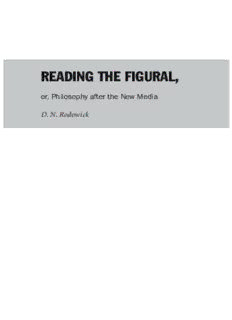
Reading the Figural, or, Philosophy after the New Media (Post-Contemporary Interventions) PDF
Preview Reading the Figural, or, Philosophy after the New Media (Post-Contemporary Interventions)
READING THE FIGURAL, or, Philosophy after the New Media D. N. Rodowick 6 9 2 f o 1 t e e h s / L A R U G I F E H T G N I D A E R / k c i w o d o R 3 4 3 READING THE FIGURAL, 6 or,PhilosophyaftertheNewMedia 5 5 : 1 1 6 2 . 6 . 1 0 0 2 g n e s T 6 9 2 f o 2 t e e h s / L A R U G I F E H T G N I D A E R / k c i w o d o R 3 4 63 Post-ContemporaryInterventions SeriesEditors:StanleyFish&FredricJameson 5 5 : 1 1 6 2 . 6 . 1 0 0 2 g n e s T 6 9 2 f o 3 t e e h s / L A R U G I F E H T G N I D A E R / k c i READING THE FIGURAL, w o d o R 3 4 3 6 or, Philosophy after the New Media D. N. Rodowick DUKE UNIVERSITY PRESS DURHAM & LONDON 2001 5 5 : 1 1 6 2 . 6 . 1 0 0 2 g n e s T 6 9 2 f o 4 t e e h s / L A R U G I F E H T G N I D A E R / k c i w o d o R 3 4 3 6 ©DukeUniversityPress Allrightsreserved PrintedintheUnitedStatesofAmericaonacid-freepaper(cid:4) DesignedbyRebeccaM.Giménez TypesetinMinionwith FranklinGothicdisplaybyTsengInformationSystems,Inc. LibraryofCongressCataloging-in-PublicationData 5 appearonthelastprintedpageofthisbook. 5 : 1 1 6 2 . 6 . 1 0 0 2 g n e s T 6 9 2 f o 5 t e e h s / L A R U G I F E H T G N I D A E R / k c i ow ForDOMINIQUEandSARAH d o R 3 4 3 6 5 5 : 1 1 6 2 . 6 . 1 0 0 2 g n e s T This page intentionally left blank 6 9 2 f o 7 t e e h s / L A R U G I F E H T G N I D A E R / k c i ow CONTENTS d o R 3 34 Preface/ix 6 Acknowledgments/xvii One PresentingtheFigural/ TheIdeaoftheFigural/ Lyotard’sLeapintotheVoid: TheAestheticbeforetheNewMedia/ ParadoxesoftheVisual,or PhilosophyaftertheNewMedia/ Two ReadingtheFigural/ RehearsingtheFigural/ FoucaultthroughDeleuze,or TheDiagrammaticsofPower/ ReadingtheFigural/ TheEndofModernism/ Three TheFigureandtheText/ FilmandtheSceneofWriting/ ‘‘Withdreamsdisplacedintoaforestofscript’’/ Hieroglyphics,Montage,Enunciation/ 5 5 : 1 1 6 2 . 6 . 1 0 0 2 g n e s T 6 9 2 f o 8 t e e h s / AL Four TheEndsoftheAesthetic/ R U G I Five TheHistoricalImage/ F E H T APleafortheDead/ G N I D SocialHieroglyphsandtheOpticsofHistory/ A E R / TheAntinomicCharacterofTime/ k c wi AnteroomThinking,or o d o R ‘‘TheLastThingsbeforetheLast’’/ 3 4 3 6 Six AGenealogyofTime/ TwoStoriesof/ TwoAudiovisualRegimes: TheMovement-ImageandTime-Image/ TheEndsoftheDialecticandtheReturn ofHistory:HegelandNietzsche/ Genealogy,Countermemory,Event/ Seven AnUncertainUtopia—DigitalCulture/ AnImageofTechnologicalAbundance/ ADigressiononPostmodernism/ ThreeQuestionsconcerningDigitalCulture/ AnImpossibleIdealofPower/ Notes/ Bibliography/ Index/ 5 5 : 1 1 6 2 . 6 . 1 0 0 2 g n e s T 6 9 2 f o 9 t e e h s / L A R U G I F E H T G N I D A E R / k c i ow PREFACE d o R 3 34 ‘‘Agoodbook,’’writesJean-FrançoisLyotardinDiscours,figure,‘‘would 6 be one where linguistic time (the time of signification and of read- ing) would itself be deconstructed: that the readercould start wher- ever s/hewishes and in whateverorder, a book for grazing’’ (; my translation).LikeLyotard’sDiscours,figure,thisisnotagoodbook,an artist’sbook,butratherabookofphilosophythatstilldreamsofsigni- fication.Butperhapsphilosophycanoperateitsownfiguraldiscourse: that of the rhizome. In this book, the figural functions as a nomadic conceptcirculatingbyknight’smovesamongsevenessayswhilemu- tatinginitsformsanddimensionsthroughitsencounterswithdiverse philosophers.Mostoftheessaysincludedherehaveappearedinsome publishedform,thoughallhavebeenrewrittenandmostexpandedto bringforwardtheirconceptuallinks.Theselinksaredetachable,how- ever. The organization of the book is somewhat nonlinear, and the orderingofchaptersisnonchronological,thoughnotrandom.Arhi- zome, then, and not a book; each chapter may be read out of order, and perhaps readers will want to find theirown paths. Consider the following,then,asonemapforreadingthefigural. Althoughtheseessayswerewrittenoveraperiodofseventeenyears, they emerged from a common research project responding to what was, for me, a fundamental intuition. Although I am a child of the seventies, and thus of a visual semiology inspired by the linguistics of Ferdinand de Saussure, a form of structural analysis inspired by Claude Lévi-Strauss, and a theory of ideology forwarded by Screen, my encounters with deconstruction and its critique of logocentrism convincedmeearlyonthatalinguisticallyinspiredsemiologywasin- adequateforthestudyofvisualculture.Moreover,withtheexplosive 5 5 : 1 1 6 2 . 6 . 1 0 0 2 g n e s T
Description: